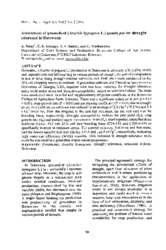Assessment of groundnut (Arachis hypogaea L.) genotypes for drought tolerance in Botswana

View/
Date
2006Author
Sesay, A.
Khonga, E. B.
Balole, T. V.
Mashungwa, G.
Metadata
Show full item recordAbstract
Groundnut (Arachis hypogaea L.) production in Botswana is adversely affected by erratic
and unpredictable rainfall resulting in various periods of drought. As part of a programme
aimed at developing drought-tolerant cultivars, two field trials were conducted in the
2004-05 cropping season to evaluate 10 groundnut cultivars and 7 breeding lines from the
University of Georgia, USA, together with two local varieties, for drought tolerance,
using yield under stress and drought-susceptibility indices as selection indices. The trials
were conducted under rain-fed and supplementary irrigation conditions at the Botswana
College of Agriculture Farm, Notwane. There was a significant reduction in pod yield (P
< 0.01), crop growth rate (P < 0.01) and partitioning coefficient (P < 0.01) due to drought
stress. Pod yield across cultivars was reduced by an average of 2.3 t ha1 (79.3 %) and 3.5
t ha'1 (88.0 %), from the irrigated to the rain-fed treatment, for the cultivars and the
breeding lines, respectively. Drought susceptibility indices for pod yield (Sy), crop
growth rate (Sc) and partitioning to reproductive sinks (Sp), used together, identified three
cultivars (GAG, 522 and 232) and two breeding lines (C24-124 and C209-6-49) as
specifically tolerant to moisture stress. The control cultivars, Nakwana and Peolwane,
had the lowest specific leaf area (SLA), 135.9 and 125.8 enrg’1, respectively, indicating
high water-use efficiency (WUE) capacity. This variation in drought-tolerance traits
could be exploited in a groundnut improvement programme.
